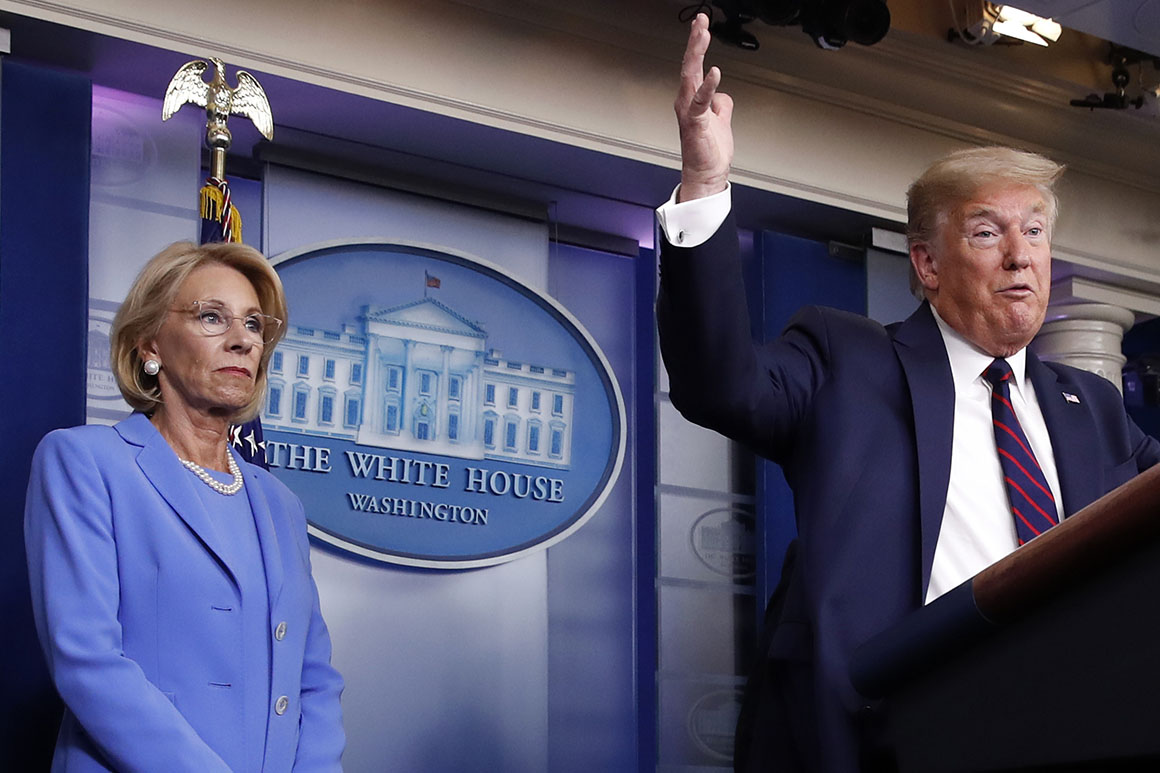
White House guidelines say dormant schools should stay closed until states log weeks of declines in flu-like illnesses and documented Covid-19 cases before considering an in-person return to class. The Centers for Disease Control and Prevention has told schools since March to consider extended dismissals of two weeks or longer, when there is “substantial transmission” of the disease in a community. The federal government has little formal power to enforce the guidelines for schools, but they do carry influence.
New CDC suggestions now say schools need to be ready to protect children and staff who are at higher risk of severe illness, and be ready to screen everyone for symptoms and a history of exposure to the disease, before reopening their doors.
Trump’s language doesn’t match that. “If anything, what we see from the White House is ‘open schools at all costs,’” said Daniel A. Domenech, who runs AASA, The School Superintendents Association.
Older teachers may have to stay home for their health, Trump acknowledges. And he says it’s up to governors to make the call on whether schools should reopen. “But their state is not open if the schools aren’t open,” he said Thursday. “So, again, it’s had very little impact on young people, and I think they should open their schools.”
The calculations for reopening are daunting.
Principals and teachers have to consider whether seats and desks should be spread at least six feet apart, whether playgrounds and lunchrooms should be closed, and whether an on-campus school day should start and end at different times for different groups of students. Schools have to account for students sharing iPads, textbooks, lockers, Bunsen burners, tennis rackets and other equipment throughout a day. They have to prepare for athletes playing contact sports who can easily spread germs to each other. Getting students to school could require extra bus drivers, new public transportation policies and drastic scheduling changes to maintain social distancing.
And all of it will cost money schools don’t have, with some advocates saying even the $100 billion House Democrats included for education in a new round of stimulus funding isn’t enough.
DeVos has been doling out billions in federal aid to states that can be spent to improve access to online classes under the latest coronavirus relief package. She has touted examples of internet-equipped buses rolling through rural regions so kids without at-home Wi-Fi can do schoolwork, and teachers using the telephone to check on students or taking to social media to connect with their kids.
She has been emphatic that learning for all students, including the most fragile or who have disabilities, can and must happen outside of physical classrooms.
“Ultimately, we know everyone is grappling with the challenge of keeping students safe and healthy while also building capacity for remote learning. It’s an important moment to realize that learning can — and does — happen anywhere and everywhere,” Devos said in late March.
When it comes to the specifics of reopening school buildings, however, DeVos, like Trump, leaves decisions to the states. DeVos’ spokesperson called the decision to reopen “a public health question,” and said the department would “assist with questions that will come up as school buildings reopen.”
Education groups worry politicians will mandate a reopening without providing the money for staffing, sanitation and transportation — or regular testing and temperature taking of students. Several said they want the administration to listen to Anthony Fauci, director of the National Institute of Allergy and Infectious Diseases, who Trump blasted for urging a cautious approach to reopening schools, saying “I totally disagree” with Fauci and accusing him of playing “both sides of the equation.”
Fauci warned that the public needed to be cautious, particularly when it came to how the virus affects children, and pointed to a spate of cases of a rare inflammatory illness being reported in young children with potential links to the coronavirus.
“You’re right in the numbers that children in general do much, much better than adults, and the elderly, and particularly those with underlying conditions,” Fauci told Sen. Rand Paul (R-Ky.) at a hearing this week, adding that more information continues to emerge about the novel pathogen.
“I am very careful, and hopefully humble, in knowing that I don’t know everything about this disease — and that’s why I’m very reserved in making broad predictions,” Fauci said.
National PTA President Leslie Boggs told reporters this week it’s important for parents to feel safe to send their students back to school, adding that she lost her own 12-year-old grandson in February. The boy died from complications with an autoimmune disease, according to a spokesperson.
“Please don’t put those children at risk and allow parents and families to grieve in a situation that no one should go through,” she told reporters during a call with the head of the National Education Association, the nation’s largest teachers union. “Please listen to Dr. Fauci and all of the physicians that are saying take this slowly and intentionally.”
Educators are cobbling together their own playbooks for a safe reopening. Domenech of the school superintendents group turned to a leaked document from the Centers for Disease Control and Prevention to advise his colleagues and set up a superintendents’ task force to recommend ways to reopen. The Chiefs For Change education group teamed up with Johns Hopkins University researchers to craft suggestions for school leaders on how to reshape the school calendar and staffing practices.
“We need politicians to step up and give our school districts what they need to provide those educators with the safety those parents expect for their students,” NEA President Lily Eskelsen García told reporters, “or this is a disaster, this is a tragedy, waiting to happen.”
Source: politico.com
See more here: news365.stream






